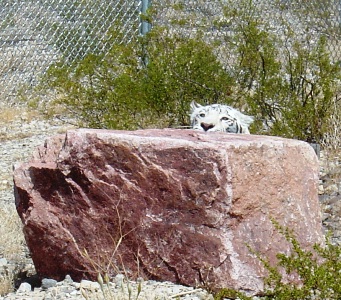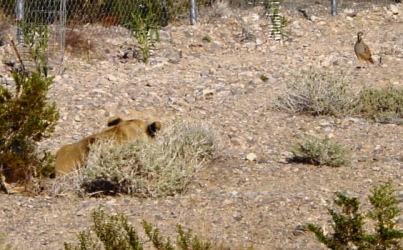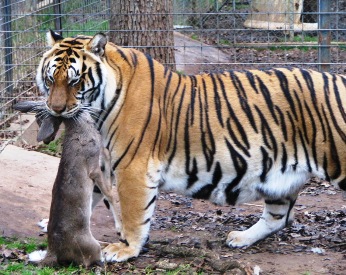 |
| This captive pet white tiger is not used to strangers and often hides from them. |
Some Thoughts on
Captive Breeding, Rewilding
and Reintroduction of Wild Cats
Zuzana Kukol, January 2007
Here is a brief look at some of the issues
with reintroducing captive
bred big cats into the wild.
CASE STUDIES:
1. Wild lynx captured, kept in captivity and released in a new territory:
Colorado Division of Wildlife lynx reintroduction program has used wild Canadian lynxes captured in Canada, some less than a year old. Other than expected fatalities due to them being hit by a car, one of the main reasons four of the first five transplanted lynx starved to death in Colorado was not their inability to hunt for food. The reason was Canadian lynx feeds almost exclusively on snowshoe hare which was in short supply in Colorado release area, and this lynx didn’t consider other animals to be food/prey.
After this initial fiasco, lynx were kept in captivity for many months to
fatten them up and then released in the Colorado state.
Colorado has spent $3.5 million since 1997 on the restoration program which
transported and released 218 lynx from Canada and Alaska. These have been
released in southwestern Colorado since 1999. Of those released at least 78
are confirmed dead, but more than 80 births have been documented since 2003,
and researchers believe the total number of lynx in the state is about 200.
January 2007 news reported that a lynx born in Colorado in 2004 gave birth
to 2 males in mid June 2006, which was the first documented case of a
Colorado-born lynx giving birth since the reintroduction program began in
1999.
2. Captive born & raised tigers in the USA:
A group of captive bred and raised tigers were confiscated and kept by the government agency as evidence for a case going to trial. There were supposedly 5-6 tigers in a multi-acre pen that had NEVER been messed with, and they had no way to separate them. They would use a tractor and a front end loader to dump deer carcasses over the top of the fence to feed the cats.
The enclosure had NEVER been cleaned in years. It was full of bones. They had no idea what sex they were or anything. Years went by and then the government agency contacted the sanctuary to take the tigers. They managed to dart all 5 or 6 tigers at once and remove them to transport cages - talk about scary!
Their current habitat is full of woods and divided into a few acres large area and a small area for feeding and cleaning, using lock down for safety if necessary. Those tigers are completely wild. Sanctuary owner almost never sees them - they totally avoid humans. For the safety of the tigers, we will not disclose their location.
 |
| This captive pet white tiger is not used to strangers and often hides from them. |
That human avoidance tendency comes naturally - and we, private pet owners or entertainers overcome it in taming and constant daily routine of human/animal interaction.
Think of it in terms of Olympic athlete that needs to train all the time, if you stop training, you might loose muscle and get fat. “Tameness” goes away naturally in some cases - that's what we call "reverting to the wild" - some particular animals grow up and loose their trust of humans and their level for comfort and they go feral.
3. Captive bred and raised pet bobcats and cougars fed live chickens:
I used to have a friend that was raising organic chickens for her captive bred cougars and bobcats. Nobody ever taught these sweet pets how to hunt, many even had a dog buddy, yet, they knew how to kill a chicken, but never harmed the dog, which they didn’t consider to be food.
4. Domestic cats going feral:
Even our captive bred and born domestic kitties are often skittish around strangers, hunt mice and bird for fun and easily can fend for themselves and go feral easily.
5. Captive big cat pets:
Other than big cats in entertainment that are used/conditioned having crowds and complete strangers around them, most captive big cats kept as pets will only get attached to their owner/keeper and be timid or even scared around strangers.
MY CONCLUSION:
If you have tigers raised by very limited number of humans and limit their interactions with humans to a minimum, they will naturally be scared and avoid the rest of the humans they never met as these are total strangers to these tigers.
Tigers are very smart, and unless conditioned daily to be around strangers, they will avoid them, not any different than many domestic cats not being too friendly to houseguests. As for hunting, many of the captive bred big cats just ‘know’ how to hunt (just like domestic cats catching a mouse).
 |
|
| 11 months old captive bred 'house pet' lion cub stalking a quail (photo Zuzana Kukol) |
When kids are on the property where big cats are kept, these captive cats just naturally stalk anything at their eye level, which kids are. This is not something you have to teach them, this is who they are. By daily training and interaction ,we the big cat trainers, are conditioning them to ‘forget’ this behavior using various distractions.
If tigers are reintroduced in some of their original habitat, and these have enough prey population, the tigers will have no reason to seek humans or their livestock, they will be more than happy to keep their distance from locals.
 |
|
|
(Photo Robert Rasmussen) |
As for hunting, I don’t really have a specific idea how to teach them how to hunt, even my own exotic cats often kill in play a snake or bird that comes to their cage, and these are exotic cats that are well fed, yet, they still like to playfully hunt.
By introducing live prey to the big cats in confinement, the same prey that they would encounter in sufficient quantities in their natural habitat once released, their chances of survival on their own and stay away from people should be pretty good. But, in case this fails, I would keep empty cages where they grew up handy for a while until the program can be called a success.
 |
| Scared but curious pet white tiger hiding from new visitors behind a bush in her big naturalistic habitat. |
(The author is based in rural US, and has been raising big cats as pets for a decade.)
Copyright 2007 © Zuzana Kukol & REXANO
www.REXANO.org